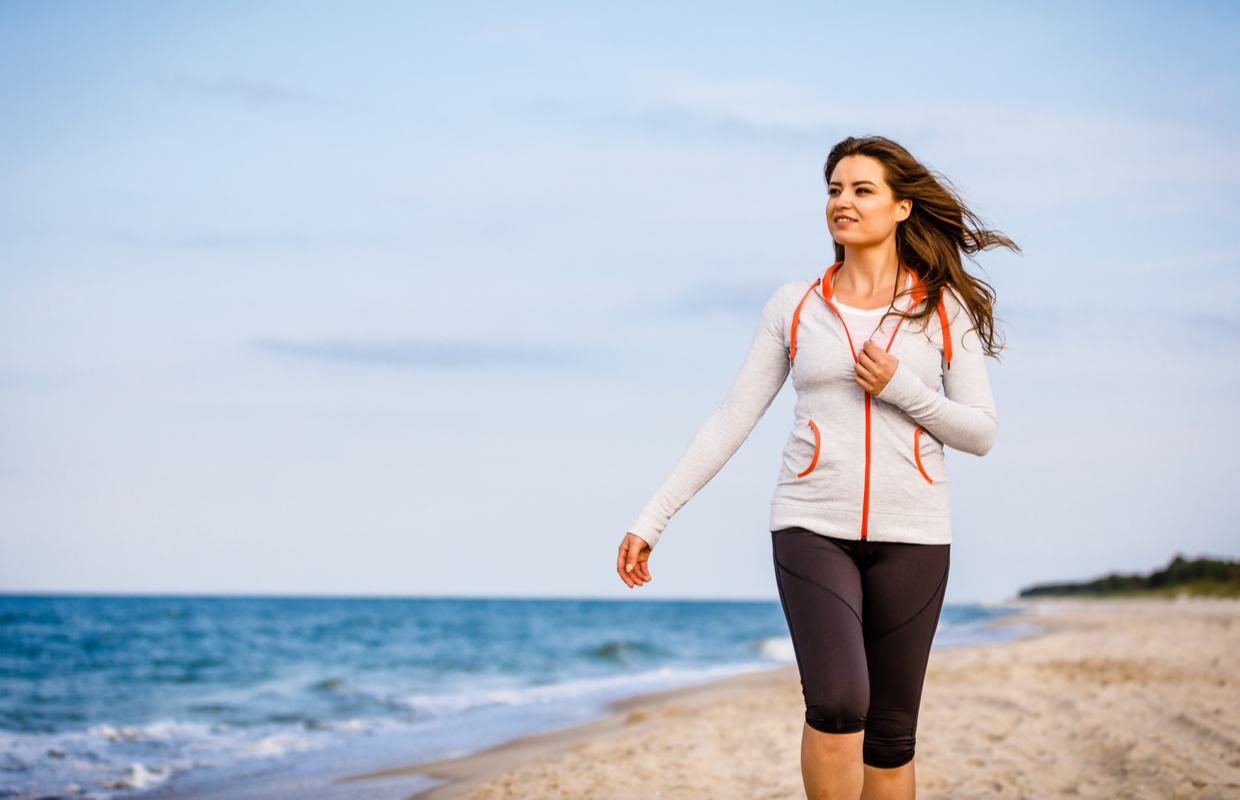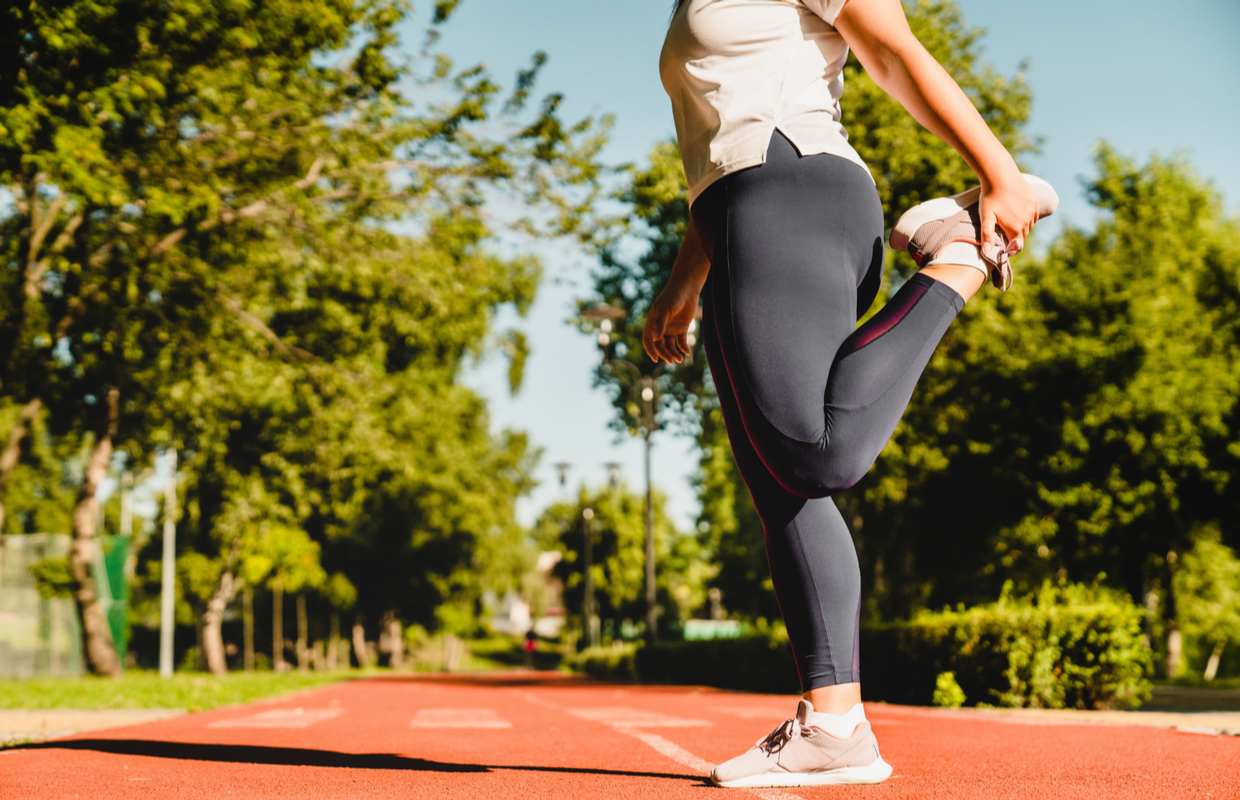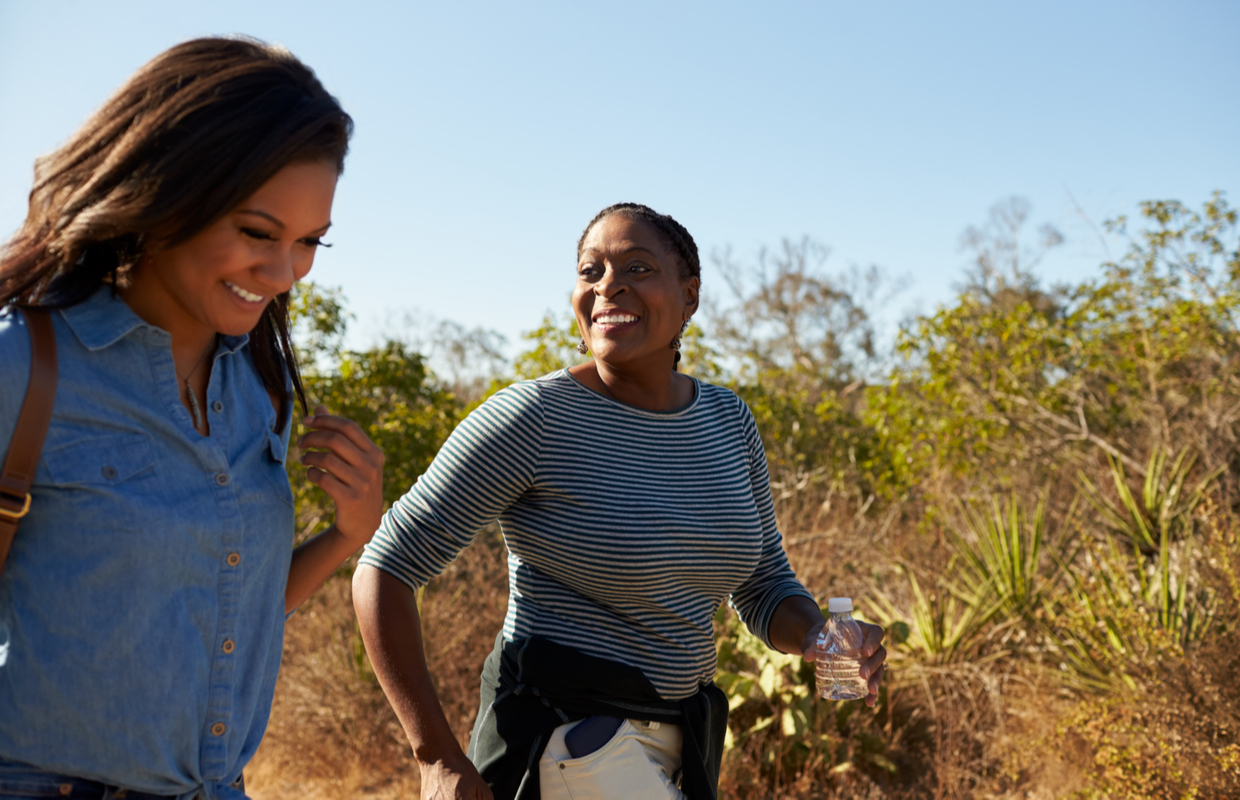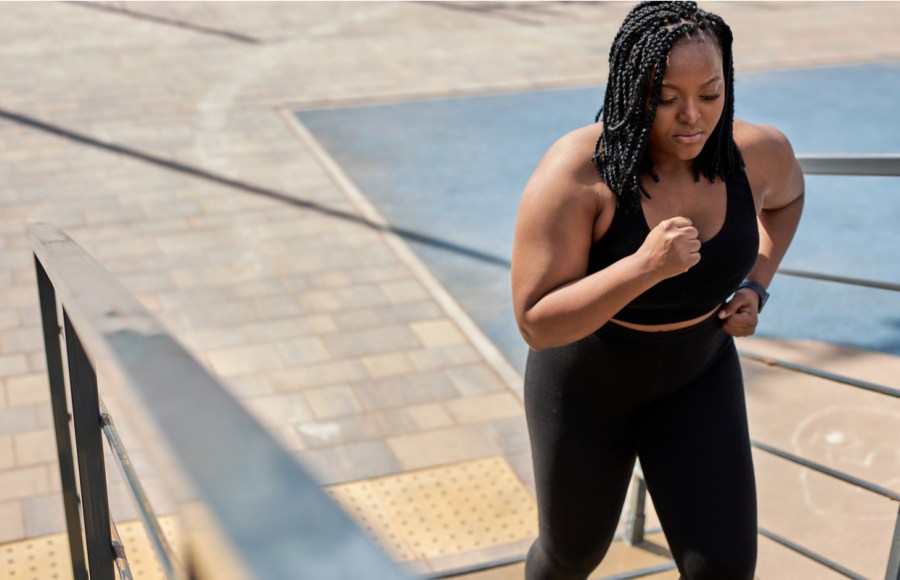Discover why walking is a good option for healthy weight loss with our expert tips and 2-week walking plan…
As well as giving your overall mental and physical health a boost, walking is a hugely beneficial activity when it comes to healthy weight loss and management. This means you can explore beautiful routes around the country (or world!) – either for some precious alone time or with family and friends – and reach a healthier weight, without it even feeling like exercise!
‘Whether you want to drop a dress size, keep fit, or take on a new challenge, walking is for you,’ says Nina Barough, founder of breast cancer charity Walk the Walk. ‘In just 2-3 weeks you’ll feel your whole body getting stronger. Personally I aim to keep a continual level of fitness through walking, which I’ll step up by focusing on speed, for example, if I have a particular challenge to meet, such as a charity walk.’
Personal Trainer Kira Mahal agrees that it won’t take long to see the physical results of walking. ‘A brisk 20-minute walk each day is all it takes to improve overall health markers,’ she says.
Why is walking good for weight loss?
‘Walking helps you target visceral fat around your waist,’ says Dr William Bird, a Berkshire GP and pioneer of Green Gyms and Health Walks. ‘Visceral fat accumulates around organs and is designed as a temporary fat store for the body. When we were hunter gatherers and
food was in short supply, we needed a fat store that could quickly be turned into energy to keep us going. It sat on the waist because there it didn’t get in the way of throwing a spear or running!’
The problem with this type of fat is that it stores hormones and proteins that cause inflammation in the arteries and cells when they get into the blood stream. ‘It’s very harmful fat, unlike the fat in other parts of your body, such as the superficial fat found just beneath your skin,’ explains Dr Bird. ‘Fortunately, because it’s designed to break down more quickly than other fat stores, it’s the first fat to go when you exercise. Even a small amount of weight loss around the waist can bring big benefits for health.’
The importance of pace for weight loss
But, you need to keep up a good pace in order to gain maximum benefit – this means walking at a brisk pace rather than a stroll. ‘Brisk walking speeds up your metabolism, which has an effect that lasts for 2-6 hours after you’ve finished,’ says Dr Bird. ‘To reap the benefits, walking has to be at a pace that leaves you slightly out of breath.’
In fact, rather than counting steps, Public Health England has urged people to focus instead on their pace and has launched the Active10 app to help. It tracks your walking and lets you know when you are going at the right speed. ‘Physical activity can be hard to sustain at times,’ says Dr Bird. ‘But if it’s combined with meeting friends and being out in nature, it’s infinitely more pleasurable, and therefore, an activity that people are much more likely to stick with.’

Benefits of walking for healthy weight loss:
You might feel walking is such an everyday thing that it’s unlikely to have any significant impact on your health, fitness or weight, but it does work! In fact, data in the Journal of Exercise Nutrition and Biochemistry reports that overweight women lost 1.1 inches from their waistline through walking for just 50-70 minutes three times a week – all from regularly putting one foot in front of the other!
‘Walking really can help with losing excess pounds,’ says Lucy Wyndham-Read, YouTube fitness and walking expert. ‘It’s a full-body workout that engages all of the major muscle groups and it trumps running in that it will encourage you to take a fuller range of motion, especially through your hips and shoulders.’ This means it can help to tone and sculpt the surrounding muscles, and when you’ve got more muscle, it boosts your metabolism so you naturally burn more calories – even while resting.
Of course, the benefits of a spritely stroll don’t stop there. Walking is low-impact so it puts less stress on the joints and bones. However, because it’s a weight-bearing activity, it can still improve bone density. ‘It’s kind on joints and also on the elasticity of skin, which makes it great for preventing unnecessary sagging skin,’ adds Lucy. ‘The list of benefits really does go on – it’s great for cardiovascular health, mental health and is an instant energy-booster, just to name a few!’
How to lose weight by walking
How do you turn an everyday jaunt into a weight-loss walk? As we touched on before, the trick is to pick up the pace. While a brisk walk will burn up to 400 calories per hour, a slow walk burns just 225 calories an hour – that’s quite a difference. ‘To get a calorie-burning effect,
it’s really important to turn up the intensity of your trek,’ says Lucy.
‘Think of it like this: the speed you stroll around the supermarket is your slow-to-moderate pace, but the speed you walk at if you’re late for a meeting is your fast pace – and this is the speed to go at if you’re going to use oodles of energy and burn calories.’ So, you see, walking doesn’t have to be an easy option, so if you’re looking to pummel pounds while you stroll, this 2-week walking for weight loss plan is for you…
Walking for weight loss: 14 top tips for beginners
1. Set the pace
Build up your speed at a gradual pace – as explained previously. You are aiming to increase it so that your heart rate speeds up, but you should still be able to breathe without gasping and be able to talk as you walk.
2. Pump your arms
Walking with straight, rigid arms will impair your technique and make you walk slower. Another common mistake is to allow your arms to swing from side to side rather than backwards and forwards. Instead, bend your arms at the elbow at a 90o angle, and swing them forwards and slightly towards the centre of your body. This will rotate your body, helping tone your waist.
To develop speed, pump your arms as you walk. The faster you go, the more calories you’ll burn. Hold them at right angles and move them back and forth.
3. Plan your route
Before you set off, plan where you will walk, so you know how far you’ll go. It’s a good idea to set a circular route so you are never far away from home.
4. Incorporate rest days
Rest days are crucial, to let your body recover when walking for weight loss. To stay mobile and active, try calm, low-impact activities such as yoga or Pilates on these days.
5. Stand tall
Try to create as much distance between your ears and shoulders as possible. This will help prevent hunched shoulders and poor posture. Keep your head in line with your spine and have your chin parallel to the ground – don’t tuck in your chin or tilt it back, and this will interfere
with your stride. To help maintain correct walking posture, imagine a vertical line from your big toe to the centre of your knee and up to your pelvis.
6. Lift your pelvis
To stabilise your pelvis, keep the front of your pelvis lifted and engage your core by keeping your abdominal muscles slightly contracted. To get the right position, imagine your pelvis contains a bowl of water and aim not to spill any as you walk. This will support your back, flatten your tummy and reduce pressure on your joints.
7. Don’t over stride
It might be tempting to take long strides, however, this could do more harm than good. The walking experts recommend taking shorter rather than longer strides – this will be better for your joints as well as your posture.
8. Use the whole of your foot
With each stride, remember to walk through the whole of your foot. Strike the ground with your heel and roll your foot through to your toes. Focus on pushing off from the ground through all your toes to help activate your glutes and keep your feet aligned.
A recent study at the University of Utah found people who walk heel-first use 83 per cent less energy than those who walk on their toes, and 53 per cent less than those who walk on the balls of their feet.
9. Adapt if you need to
If you’re new to power walking, it may be tiring to begin with. If this is the case for you, use your arms in the way described above for five or 10 minutes, then lower your arms and just let them swing naturally to allow them to recover. As soon as you feel rested, raise them again. To build strength in your arms, you could try doing some upper body exercises with dumbbells to increase your endurance.
10. Avoid tension in your hands
Remember to keep your hands in a relaxed fist – don’t clench! If your hands are tight it will create unnecessary tension in your arms and shoulders. It also uses up quite a bit energy – and you want to keep all your energy for walking!
11. Engage your glutes
To tone up your bottom, concentrate on pushing off with your big toe and little toe after you roll through your heel with each stride. This will help engage your glute muscles more effectively.
12. Keep the spine lengthened
Try to create some distance between the bottom of your ribcage and the top of your pelvis. This will naturally lengthen your spine. Drop your shoulders and imagine that you are leading from your sternum as you walk, which will keep your chest open and your ribcage slightly forward. This will also make it easier for you to breathe more efficiently and give your muscles more oxygen.
13. Focus on your breathing
For optimum breathing technique, breathe in through your nose and out through your mouth. Your nasal passages offer more resistance to the air than breathing through the mouth, and this will help keep your lungs strong and elastic. Breathing out through your mouth will help cool you down. Try to take deep breaths that fill your lungs – short, small breaths won’t utilise your lung capacity to the full.
14. Look ahead
Focus your eyes on the ground about five to 10 metres ahead. If you need to look at the terrain closer to your feet, aim to tilt your eyes, rather than your head. If you extend your head forward your body will go out of alignment and you could place excess strain on your neck and shoulders, which will put you off balance and lead to undue fatigue.
2-week walking plan for healthy weight loss
The beauty of walking is that you can just open your front door and go,’ says Walk the Walk’s Nina Barough. ‘But, before you set off, follow my tips to make your walking sessions even better…

Walking for weight loss plan: week 1:
MONDAY: 15 MINUTES OF BRISK WALKING
It’s the first day of your new walking for weight loss plan, so enjoy it. Plan it into your day, pick a nice park or some nearby countryside and get going! Wear trainers or walking shoes with a fairly flexible sole. If you’re walking off-road, invest in a pair of trail shoes, which have extra grip for muddy paths.
Related: Best walking shoes and hiking boots for women
TUESDAY: 15 MINUTES OF BRISK WALKING
In these first few days, you’re aiming to start building your fitness and make walking a habit. Think about the best time of day for your walks and schedule them in. You might find getting up a bit earlier hard at first, but the reward is watching the sunrise!
WEDNESDAY: 20 MINUTES OF BRISK WALKING
Find a local walk that takes in some hills. They don’t have to be huge steep slopes – just some undulation to challenge you a little and get you working a bit harder. Aim for 20 minutes and really power up the hills, using your arms as accelerators.
Adding in these hills helps build strength in your legs and bottom, and boosts the cardiovascular benefits of your daily walk.
THURSDAY: 20 MINUTES OF BRISK WALKING
Today, add in some strength work for your upper body. Every five minutes or so, stop at a bench and do 10-15 press-ups. Start with your body in a straight line, either place your hands on the bench backrest (easiest) or on the seat (harder) and lower yourself up and down. If you’re not in a park, use a tree or wall for standing press-ups.
FRIDAY: 20 MINUTES OF BRISK WALKING
Focus on your pace and technique. Good posture will help you avoid getting aches and pains from your daily strolls, so make sure you’re not
slouching forward or looking at the ground. Imagine a string from the top of your head, pulling you up tall. See if you can keep up that briskness for the whole walk without unconsciously slipping into a stroll.
SATURDAY: 20 MINUTES OF BRISK WALKING
Today when you’re out on your walk, find a step or park bench every five minutes and step up on to it, then step back down. Lead with your right leg, then step back down with the right leg first. Then step up with the left, stepping back down with the left. Aim for 6-8 step-ups each time you stop.
SUNDAY: REST DAY OR MOBILITY WORK AT HOME
Complement your walking with a Pilates or yoga YouTube video to help build up your core stability and get the good mobility needed for fast,
efficient walking. Some well-chosen stretches can help you avoid some potential pitfalls of walking, such as achy backs and stiff legs and feet.
We love Brett Larkin’s Easy Yoga for Your Feet and Ankles (15-min). You can find it on YouTube.
Walking for weight loss plan: week 2

MONDAY: 25 MINUTES OF INTERVAL WALKING
Warm up by walking for five minutes. Then, do two minutes at a pace that you couldn’t sustain for the whole walk, so you are a bit more out of breath than usual; then two minutes at a steady pace. Do this four times. Then, walk at a steady pace for the final four minutes.
TUESDAY: 25 MINUTES OF BRISK WALKING ON A HILLY ROUTE
Return to your previous hilly route, or find a new one. If it only has one or two short inclines, walk up them, back down and up them again, then continue with your walk so you get as much of a hill challenge as possible.
WEDNESDAY: 25-30 MINUTES BRISK WALKING
Stride out briskly and make sure you keep up the pace. Swing your arms to help your speed and look ahead of you. Repeat the upper body
work you did in Week 1 by stopping to do some bench or tree press-ups every five minutes. Try to add five press-ups to the number you
managed last week.
THURSDAY: 20 MINUTES OF BRISK WALKING
Walk for five minutes to warm up. Then every three minutes, lunge walk for 16-20 paces. Keeping your torso upright, take a big step forwards and bend your front knee to 90 degrees (or as close as you can get it), push back up, swing the back leg through and repeat. Lunge walking opens up your hip flexors and strengthens the muscles in your legs and bottom.
FRIDAY: REST DAY
If you want to, you can do a 15-minute steady walk. Include some mobility work at home as well, as you did on the Sunday of Week 1. Some stretches or a yoga session would be perfect. Maintaining mobility and flexibility will mean that you can walk further and faster without picking up injuries from tight hips or lower back.
SATURDAY: 30 MINUTES OF BRISK WALKING#
Add in intervals into your training once again. Warm up by walking at a steady pace for five minutes and then aim for three minutes at a higher pace, with two minutes of recovery. Do this four times so you get 20 minutes of interval training. Finish with five minutes at a steady pace to cool down.
SUNDAY: 35 MINUTES OF BRISK WALKING
You can walk for longer if you wish! Your stamina and strength will have progressed hugely in the past fortnight because of all of the work that you’ve put in. Enjoy your new fitness and keep up with the moves you’ve done in the last two weeks, such as press-ups and bench stepping.
You’ll notice that walking for this length of time at a brisk pace feels easier. The world is now your walking oyster!








